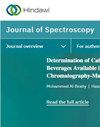Detection Storage Time of Mild Bruise’s Loquats Using Hyperspectral Imaging
IF 2.1
4区 化学
Q4 BIOCHEMICAL RESEARCH METHODS
引用次数: 1
Abstract
Bruise may cause spoilage, reduce commodity economic value, and give rise to food quality and safety concerns. Therefore, it is crucial to detect whether a loquat is bruised and when it is bruised to save storage and transportation costs. At present, the bruise of loquats is mainly discriminated by the operator’s naked eye, which is affected by personal habits, light intensity, and subjective psychological factors. The detection method is time-consuming, inaccurate, inefficient, and difficult to identify the bruise’s time of loquats. Due to the fact that the color features can be used to perform the conditions of the darkened and brownish regions in bruise’s loquats, the combined spectral information and the color features method is proposed to accurately detect the storage time of mild bruise’s loquats in this study. In order to reduce economic losses, different methods are used to deal with the loquats at the corresponding bruise’s time. Loquats with four types of bruise’s time, including 6, 12, 24, and 36 h, are studied. Models with four types of characteristics, including spectral information, RGB features combined with spectral information, HSI features combined with spectral information, and mixed color features combined with spectral information (mixed-spectral), are established based on linear discriminant analysis (LDA), support vector machine (SVM), and least-squares support vector machine (LS-SVM). The investigated 400 independent samples with four bruise’s time conditions are utilized to assess the classification ability of the proposed methods. The results indicate that the Mixed-RBF-LS-SVM model has the lowest errors, and the accuracies of storage time of mild bruise’s loquats at 6, 12, 24, and 36 h are 100%, 92%, 92%, and 100%, respectively. The overall accuracy of the LS-SVM model based on mixed-spectral is 96%, and it demonstrates that the combined spectral information and color features method can be used to accurately detect the bruise’s time of loquats. Finally, the LS-SVM model based on mixed-spectral is optimized by UVE, SPA, CARS, and GA, respectively; it is found that the UVE-LS-SVM model based on mixed-spectral is the best, and the overall accuracy is 92%. It also lays a foundation for future studies about detecting the bruise’s time of fruits with a high-precision, rapid, and nondestructive measurement.利用高光谱成像技术检测轻度瘀伤枇杷的贮藏时间
碰伤会导致食物变质,降低商品的经济价值,并引起食物的质量和安全问题。因此,检测枇杷是否破损,何时破损,对于节约储运成本至关重要。目前,枇杷瘀伤主要靠操作人员肉眼判别,受个人习惯、光照强度、主观心理等因素的影响。该检测方法耗时长、不准确、效率低,且难以确定枇杷的瘀伤时间。由于颜色特征可用于表征瘀伤枇杷的暗区和褐区情况,因此本研究提出将光谱信息与颜色特征相结合的方法来准确检测轻度瘀伤枇杷的贮藏时间。为了减少经济损失,在相应的损伤时间,对枇杷采取不同的处理方法。研究了6、12、24、36 h四种类型的枇杷瘀伤时间。基于线性判别分析(LDA)、支持向量机(SVM)和最小二乘支持向量机(LS-SVM),建立光谱信息、RGB特征结合光谱信息、HSI特征结合光谱信息、混合色彩特征结合光谱信息(混合光谱)四种特征的模型。利用调查的400个具有4种瘀伤时间条件的独立样本来评估所提出方法的分类能力。结果表明,混合rbf - ls - svm模型误差最小,6、12、24、36 h轻度淤伤枇杷贮藏时间的准确率分别为100%、92%、92%、100%。基于混合光谱的LS-SVM模型总体准确率为96%,表明光谱信息与颜色特征相结合的方法可以准确检测枇杷的瘀伤时间。最后,分别采用UVE、SPA、CARS和遗传算法对基于混合光谱的LS-SVM模型进行优化;结果表明,基于混合光谱的UVE-LS-SVM模型效果最好,总体准确率达到92%。为今后高精度、快速、无损检测水果损伤时间的研究奠定了基础。
本文章由计算机程序翻译,如有差异,请以英文原文为准。
求助全文
约1分钟内获得全文
求助全文
来源期刊

Journal of Spectroscopy
BIOCHEMICAL RESEARCH METHODS-SPECTROSCOPY
CiteScore
3.00
自引率
0.00%
发文量
37
审稿时长
15 weeks
期刊介绍:
Journal of Spectroscopy (formerly titled Spectroscopy: An International Journal) is a peer-reviewed, open access journal that publishes original research articles as well as review articles in all areas of spectroscopy.
 求助内容:
求助内容: 应助结果提醒方式:
应助结果提醒方式:


